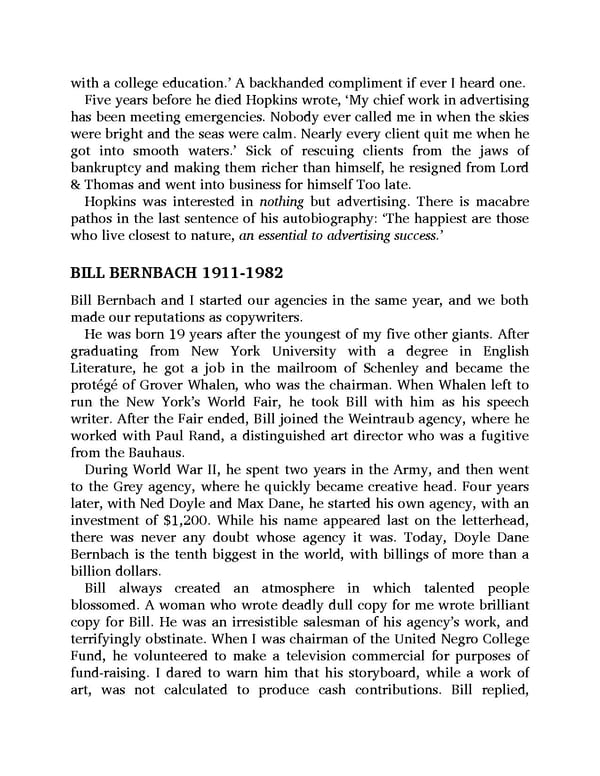with a college education.’ A backhanded compliment if ever I heard one. Five years before he died Hopkins wrote, ‘My chief work in advertising has been meeting emergencies. Nobody ever called me in when the skies were bright and the seas were calm. Nearly every client quit me when he got into smooth waters.’ Sick of rescuing clients from the jaws of bankruptcy and making them richer than himself, he resigned from Lord & Thomas and went into business for himself Too late. Hopkins was interested in nothing but advertising. There is macabre pathos in the last sentence of his autobiography: ‘The happiest are those who live closest to nature, an essential to advertising success.’ BILL BERNBACH 1911-1982 Bill Bernbach and I started our agencies in the same year, and we both made our reputations as copywriters. He was born 19 years after the youngest of my five other giants. After graduating from New York University with a degree in English Literature, he got a job in the mailroom of Schenley and became the protégé of Grover Whalen, who was the chairman. When Whalen left to run the New York’s World Fair, he took Bill with him as his speech writer. After the Fair ended, Bill joined the Weintraub agency, where he worked with Paul Rand, a distinguished art director who was a fugitive from the Bauhaus. During World War II, he spent two years in the Army, and then went to the Grey agency, where he quickly became creative head. Four years later, with Ned Doyle and Max Dane, he started his own agency, with an investment of $1,200. While his name appeared last on the letterhead, there was never any doubt whose agency it was. Today, Doyle Dane Bernbach is the tenth biggest in the world, with billings of more than a billion dollars. Bill always created an atmosphere in which talented people blossomed. A woman who wrote deadly dull copy for me wrote brilliant copy for Bill. He was an irresistible salesman of his agency’s work, and terrifyingly obstinate. When I was chairman of the United Negro College Fund, he volunteered to make a television commercial for purposes of fund-raising. I dared to warn him that his storyboard, while a work of art, was not calculated to produce cash contributions. Bill replied,
 Ogilvy on Advertising Page 290 Page 292
Ogilvy on Advertising Page 290 Page 292